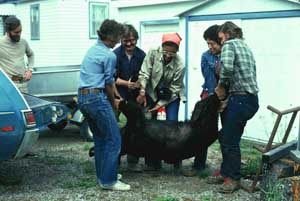 1 road-killed black bear DHJanzen100914.jpg high resolution
|
|
|
|
A 350 pound adult male black bear (Ursus americanus, Ursidae) that was hit by three cars at high speed on a Michigan Interstate highway at 3 am, badly damaging the cars, and ending up seemingly crippled in the ditch. The State Highway patrolman shot him in the head three times, missing all three times (which fortunately meant that the skull eventually made a good specimen) but then the bear died of internal injuries (see below). The State Game Warden called us at the University of Michigan Biological Station near Pellston, Michigan and asked if we wanted the bear (I had earlier called him and said that if any large animals were killed on the road, please to call us because our field biology course would like them for dissection). So, we got the bear early in the morning, here being unloaded from a station wagon. Both Ron Pulliam (checkered shirt) and Ron Carroll (dark blue shirt and moustache) are now Professors of Biology at the University of Georgia (but unloading the bear was not the reason why). Black bears range (ranged) through out most of the US and southern Canada. They hibernate in caves or other cavities during the winter months, give birth to litters of 1-3 cubs shortly before the end of hibernation, and are extremely omnivorous - their food ranges from tiny ants to moose. While the black bear is the largest/heaviest extant carnivore throughout most of the US - except in those places where the much larger grizzly bears still exist - for most of its evolutionary history it would have shared its habitat with several species of much larger Pleistocene bears, large Pleistocene cats and large Pleistocene wolves. Obviously the black bear survived the Pleistocene extinctions 11 thousand years ago, and it probably did so not because it was too fierce for the Pleistocene hunters, but rather because as the large herbivore density was depleted by human hunters, it was able to survive on a great variety of smaller prey and fruits/seeds (including acorns). The black bear diet has much in common with that of free-ranging pigs (as well as humans). |
||
back to lecture slides
or skip to: